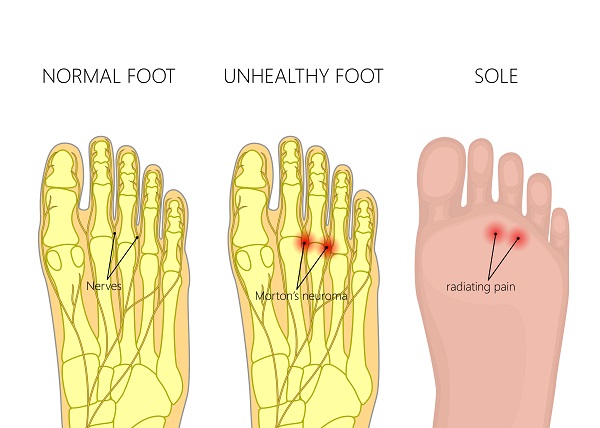
Neuroma pain is one of the more common foot complaints a podiatrist will see. It is simply an enlargement of the nerve branch that travels on the bottom of the foot and goes out into the interspace area. The pain can become so severe that you’ll give up on running, hiking or even enjoying a walk with friends or family. The foot pain is always on your mind.The symptoms of a neuroma will involve a very localized pain in the ball of the foot that is often described as a feeling of “fullness”. There may be some symptoms of radiation (a burning or tingling) as well as some swelling in this area. Many times patients will say they feel as if they’re walking on something, like maybe their sock is wrinkled, but when they take off their shoe and there’s no wrinkle in the socks.
There may also be a burning sensation in the foot and toes. Typically, this pain is between the second and third toes or the third and fourth toes in the webspace area.
What causes a neuroma?
There are various causes of a neuroma, some may be structural in nature, and sometimes it may be from an injury or from wearing shoes that fit too tight. A common story is the experience of someone with a tight ski boot.
There could be indications metabolically for the nerve to be more sensitive to irritation in this area and this could be the case for patients with diabetes. In this region, the nerve travels beneath a ligament that runs across the ball of the foot. This ligament works as a source of irritation, much like the ligament would in the case of carpal tunnel syndrome in the hand. Lastly, it is very important to understand there may not always be a direct cause- this is an issue that sometimes can just happen.
Treatment options for neuroma pain
If you feel as if you may be experiencing any of these symptoms and it’s an acute situation, you can reconsider the shoe gear you’re wearing. You may even be able to take an anti-inflammatory and avoid walking on hard surfaces at the beginning.
Our treatment for neuroma pain at Anderson Podiatry Center is multifaceted. Most foot specialists recommend custom-made orthotics, but you also have the option of using store-bought devices. However, please note that these are not going to structurally help the foot as much, and in many times are not as effective compared to something designed specifically for your foot.
- The use of orthotics is to help stabilize the bone structure and ligaments in this area so they are not rubbing and irritating the nerve branch. Cortisone can also be used, but it is typically not a long-term solution since there is a concern of damaging the nerve.
- Laser is another treatment we often use as we have deeply penetrating MLS lasers. Another means of treatment for this specific area is regenerative medicine. We are in the early stages of using this as a treatment plan, and with the limited number of cases we’ve done, there have been impressive results.
- Finally, surgery is also recommended, but in the majority of cases can be avoided. The surgical approach that we advise is utilization of a decompression procedure. In most cases, the neuroma is not removed, but rather the ligament that binds down on the nerve is released so that it no longer irritates the nerve. Patients can walk immediately after surgery and the success rate is very high.
If you find that you’re having this type of problem, it’s important that early detection and intervention is done.
